
Stinkytown and the Flies
(written by Dr. Les Crocker and Anita Taylor Doering, Archives staff)
Movies and TV productions set in the past always present a sanitized version of how life really was. Without Smell-O-Vision and the constant buzz of flies their portrayal is less than accurate.
Consider what La Crosse smelled like in the past. In 1880 there were about 2000 horses in La Crosse. The average size buggy horse produced 30 pounds of manure a day. A brewery horse dropped about 50 pounds of manure. So, figuring an average of 40 pounds per horse comes out to 80,000 pounds of horse manure on the streets and in the stables of La Crosse every day. Forty tons of horse manure, plus all the urine-soaked straw from the stables and the urine-soaked dirt that passed for streets in many parts of town.

C. & J. Michel Brewing Co. horse-drawn wagon
There were 11,000 people in La Crosse in 1875, figure an average of five people to a house and you get over 2,000 houses, each with an outdoor privy. Dumping wood ashes from the stove into the privy helped somewhat but privy maintenance varied considerably from house to house I'm sure.
Some people kept pigs and pig manure really stinks. There were lots of chickens and geese in town contributing their share of waste in back yard pens. But we aren't done yet, it wasn't just people and animals.
The breweries had a lot of waste such as the used fermented mash. Some was dumped in the marsh to the north (perhaps why so many geese lived there), Heileman dumped along the Mississippi river bank, Michel and Bartel dumped in the marsh to the south of town.
Before the locks and dams were built the Mississippi river at La Crosse had considerable variation in depth. Dry summers resulted in exposed mudflats, dead muscles and fish kills.
Horse manure, people waste, brewery leftovers and mudflats made for a very aromatic atmosphere, in the summer especially. Where there is protein waste there are flies. Lots and lots of flies and lots of stink. This was nothing new. The twin problems of waste and flies is as old as the first village that humans created.
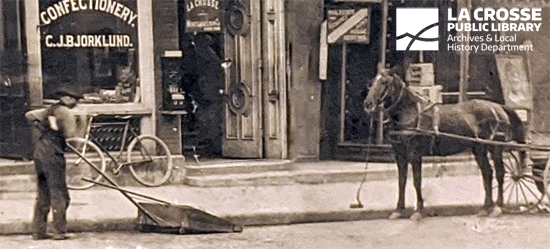
A rare view of street sweeper in action in a formal photograph of 1889 on the 300 block of Main Street. Photo courtesy of the Leithold family and altered for clarity.
But don't take my word for it, here are the words of the city physician in 1882:
To the Board of Health, City of La Crosse, July 1882, from City Physician Dr. John A. Renggly:
"...you encounter places which breed deathly (sic) and for the general health of the City most disastrous products. We will only point out to you the swamps, located within the city limits; the many streets particular the street-crossings, which, after every heavy rainstorm are dirty and stinking water pools; the condition of many of the yards of slaughter houses; and the filth, collected in most of our alley, the pigstys (sic) adjoining the alleys, whose stench is very offensive, the many places in the City where stinking manure is deposited and finally the carcasses of small and large animal (sic) left on the surface to decay, within the immediate vicinity of the city. These are sources of diseases, not only very prolific, but also dangerous in a high degree; they are the principal causes of typhoid fevers, diphtheria, scarlet fever, measles, miliaria, mouthsores." He goes on to say that the "nuisance inspectors" are appointed to enforce the ordinance, "but it has done very little to abrogate this evil."
The idea that flies spread disease was not accepted by most people at the time. Flies were annoying, but a part of life. In the South people who could afford them used dining table fly traps, domed glass forms about six inches in diameter on legs about two inches high with a turned up interior rim, like a gutter, on the inside of the dome. Flies could crawl under the dome to get the food bait under them. When the flies were full and flew away they went up and were trapped under dome and fell into the gutter. The La Crosse County Historical Society does not have any examples of such a trap and my survey of local historians met mostly with blank stares. They may have been a Southern thing.
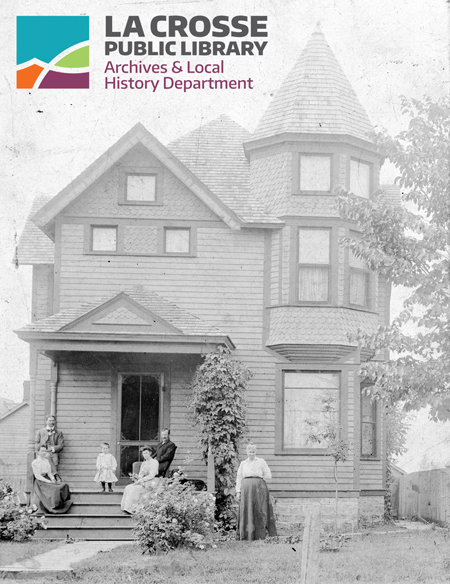
2218 Cast Street, circa 1900. Early example of a screen door
Closing interior window shutters could reduce the flies but also cut off any breeze and interior shutters were a luxury that most people couldn't afford. Curtains of loosely woven cloth, almost like gauze, were cheaper than shutters and kept out some flies but also reduced air circulation. Something else was needed.
We don't know when wire screen came to La Crosse, there is no mention of it in the advertisements in the city directories or in the newspapers from the 1870s or 1880s that I've found.
However, on June 19, 1874, the “Winona Daily Republican” ran an advertisement by M. Maverick:
“Maverick has received 10,000 feet of Wire Cloth, assorted Drab, Blue, Grey, Figured Landscape, Green and in assorted widths of 24, 26, 28, 30, 32, 34, 36 inches.
No family should be without it.
Mosquitoes and flies Cry about It.
Only 40 cents a yard and no charge for putting it on the frame. Come and see our assortment.”
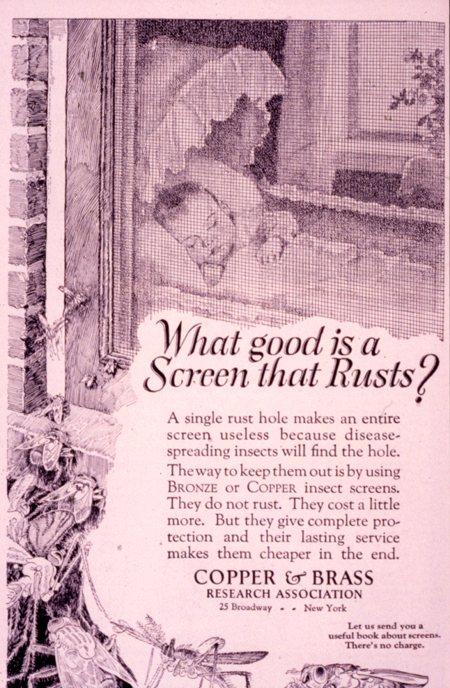
1926 advertisement for window screens
If woven wire cloth was in Winona in 1874 it should also have been La Crosse. While 40 cents a yard seems cheap the standard wage for most unskilled men at the time was a dollar a day. A four-foot-high window screen twenty-four inches wide cost most of a 10-hour day's wage.
Even with the relatively high cost I would expect some houses to have screen doors at least. However, looking at photos from the 1880s taken in the summer I have never seen window or door screens on a house. Even middle-class houses don't show any.
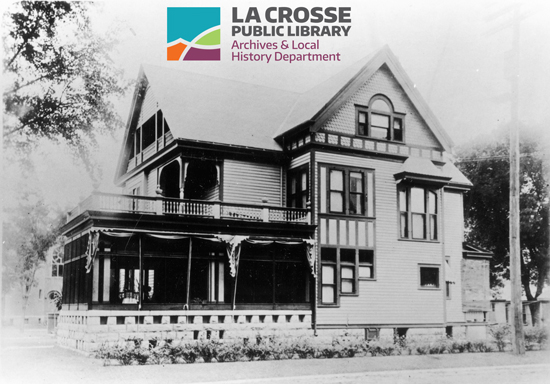

718 Main Street (both photos), circa 1913. Notice the elaborate framing of screens to enclose the existing stone porch.
Mass production and more understanding about disease changed everything. Jumping ahead twenty years, The Montgomery Ward & Co. catalog from1895, the earliest one I've seen, has screen doors from $.75, $1.15 and $1.50, depending on the wooden decoration of the frame. Adjustable window screens in a simple frame 24 by 26 inches cost 25 cents. Since most basic houses had single hung windows, where only the bottom sash could be raised, this was a very affordable cost even when combined with a screen door. Their appearance in the mail order business clearly shows that wire cloth or screens had become part of everyday life.
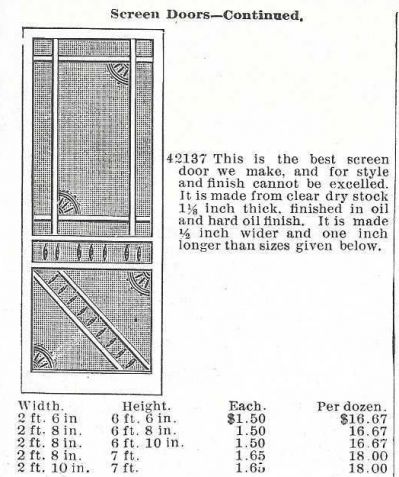
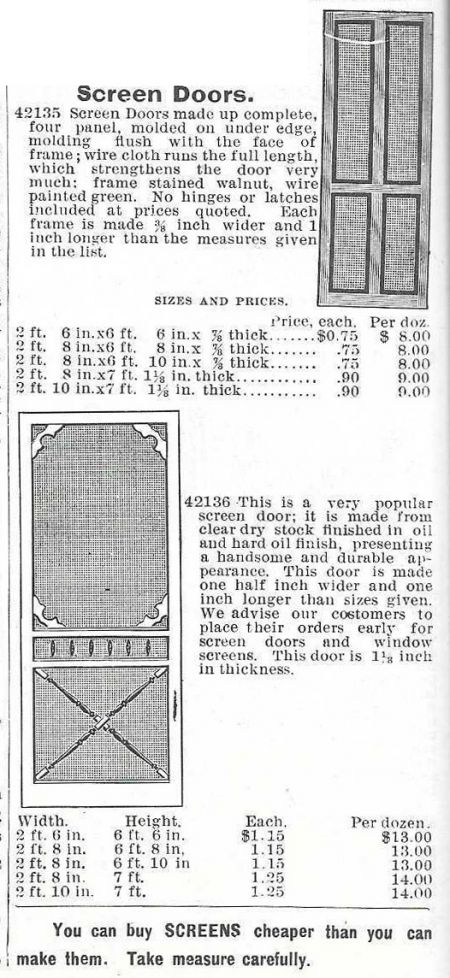
Screen door pricing from Montgomery Ward & Co.'s catalog
The glass dome flytrap mentioned earlier was now replaced with an inexpensive wire, double cone trap that could be used anywhere, but I doubt they were on the dining room table anymore.
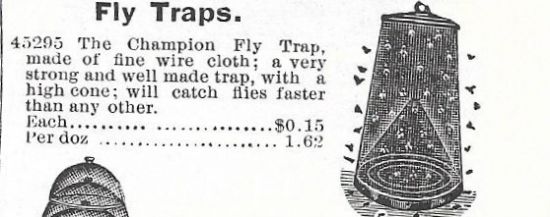
Fly trap pricing from Montgomery Ward & Co.'s catalog
By 1895 large screened porches were appearing on La Crosse houses and the fly and mosquito problem was at least alleviated if not solved. But the stink lived on until there were sewer lines and public health laws.
So, the next time you watch your favorite western movie put the TV in the bathroom, dump a load of manure in the tub, open the window and take down the screen for a more realistic experience.
